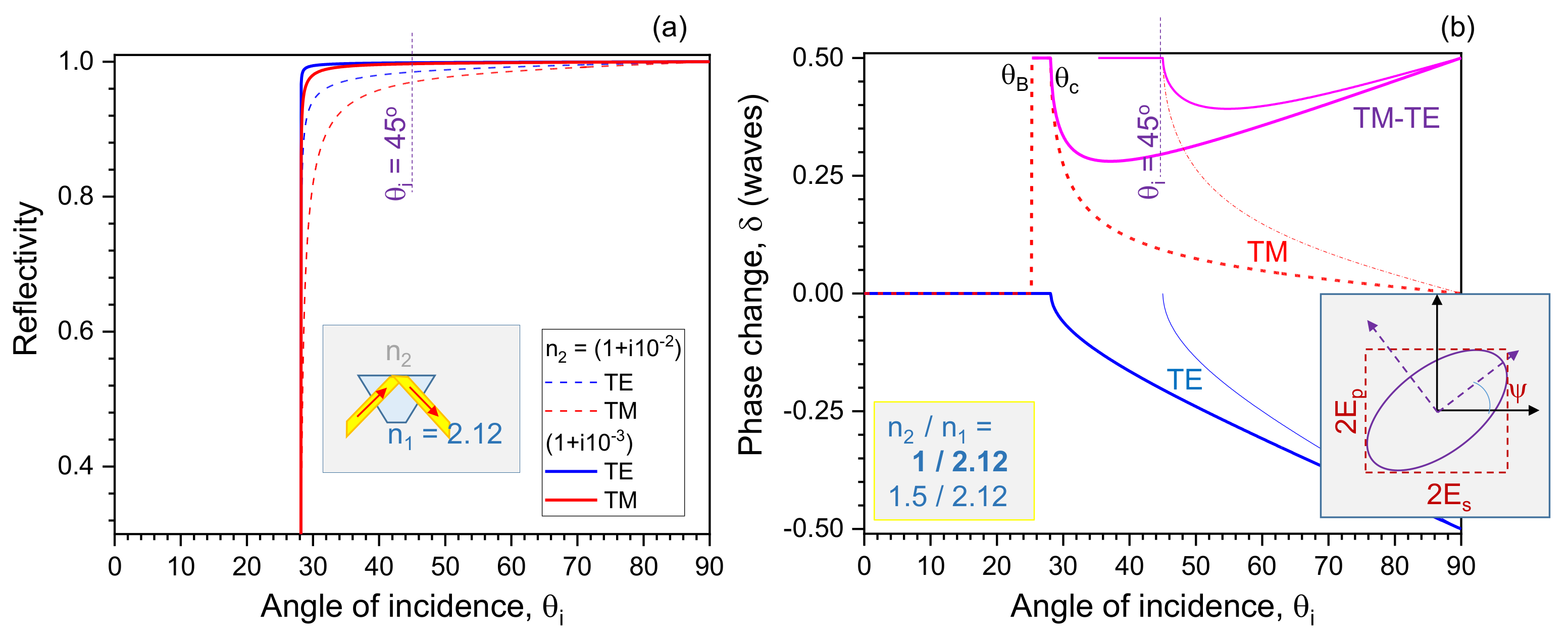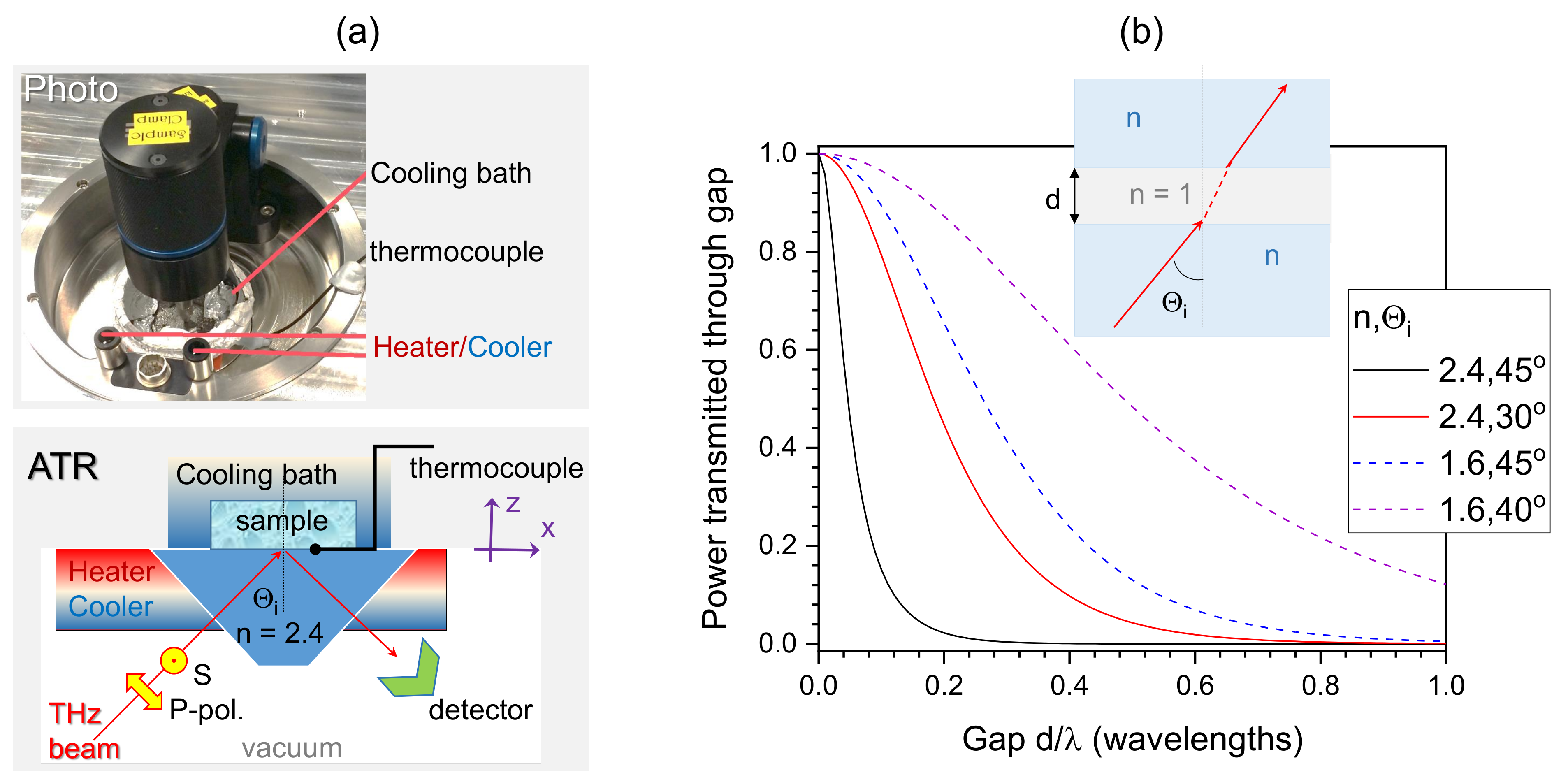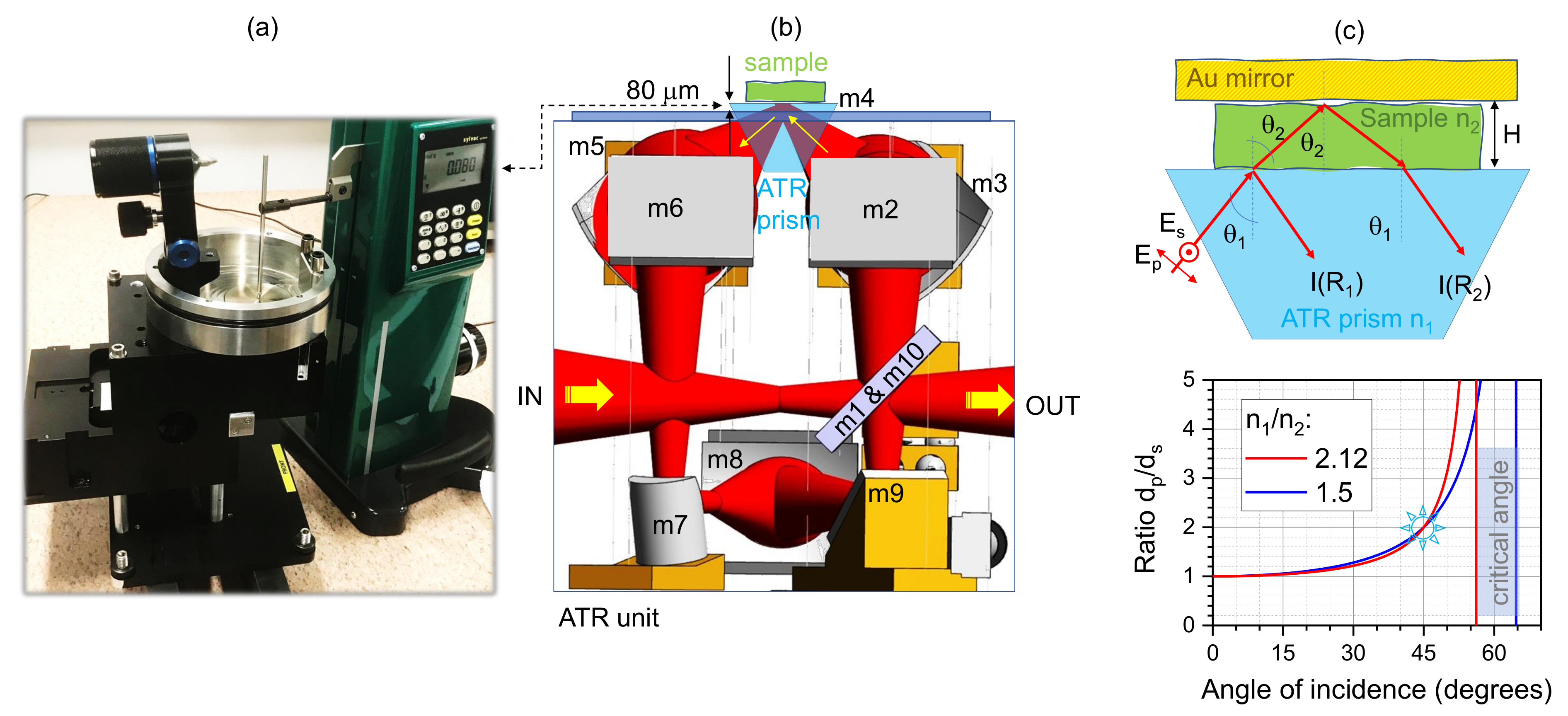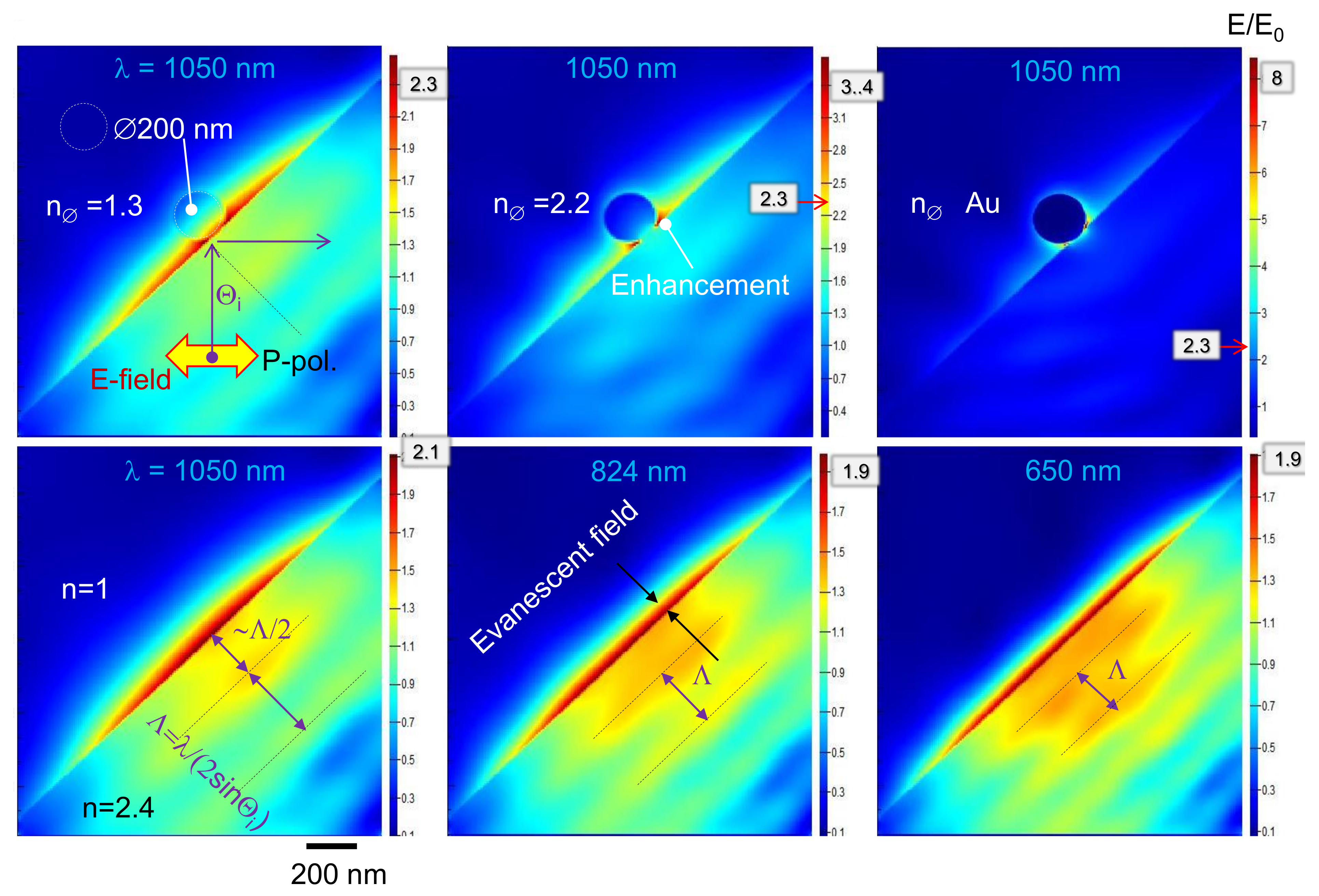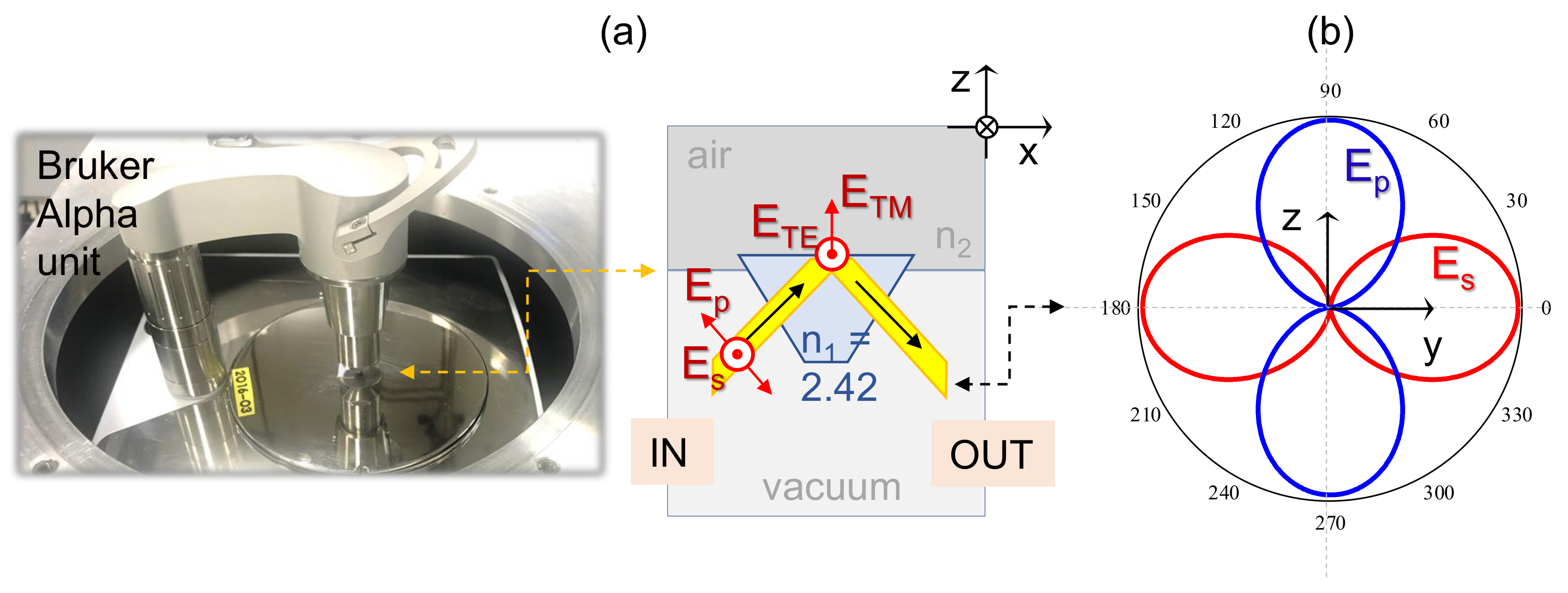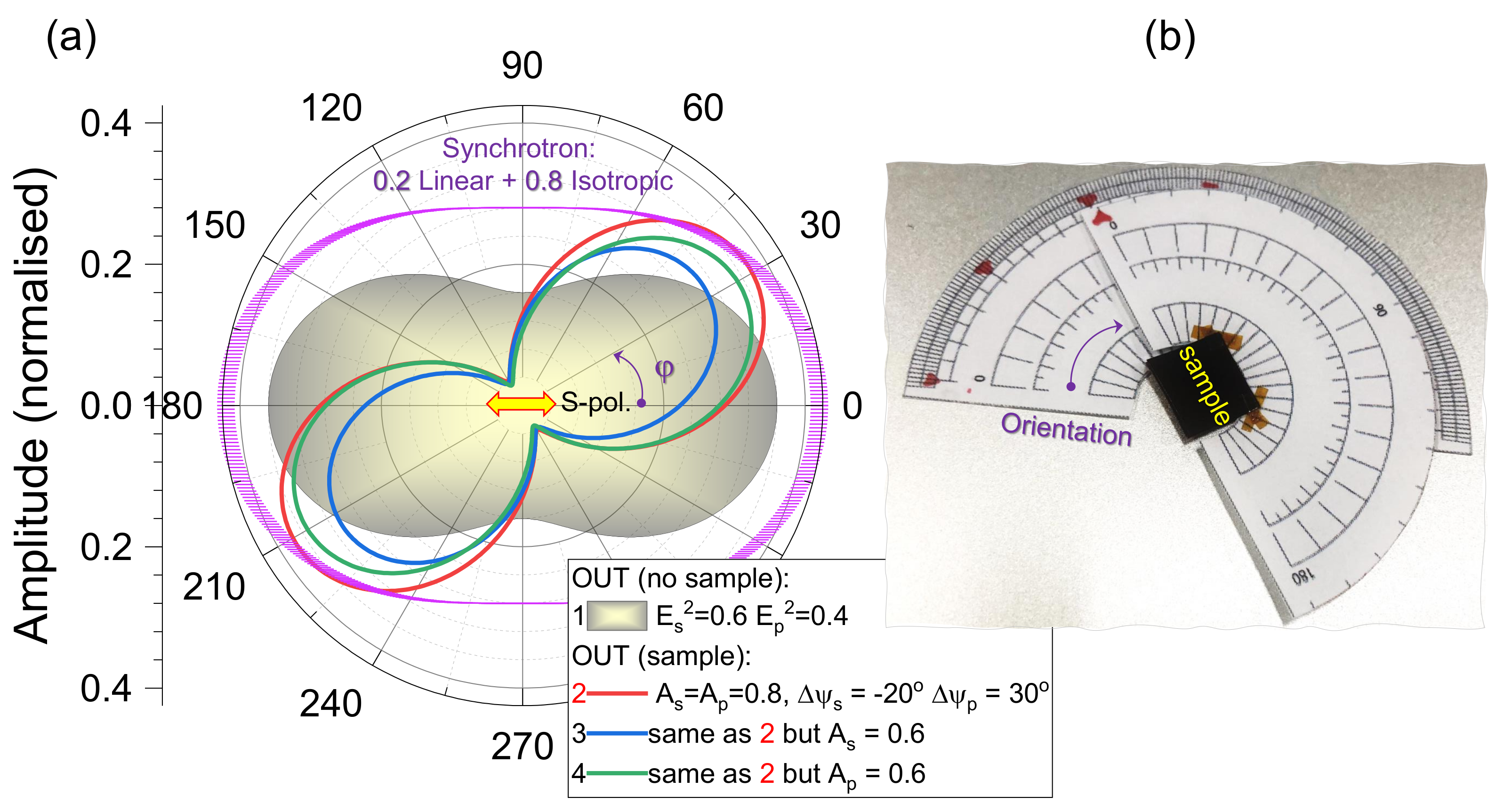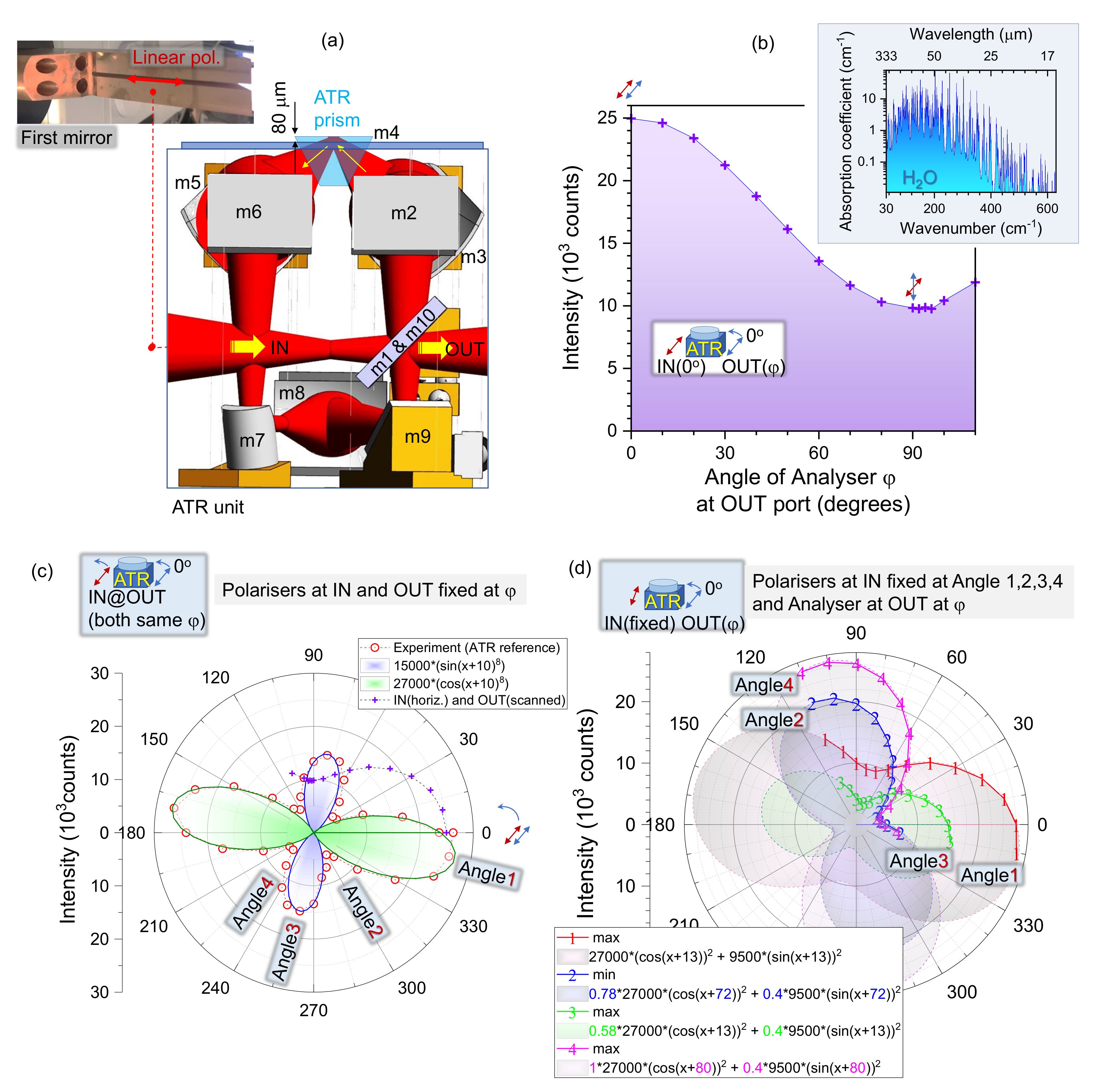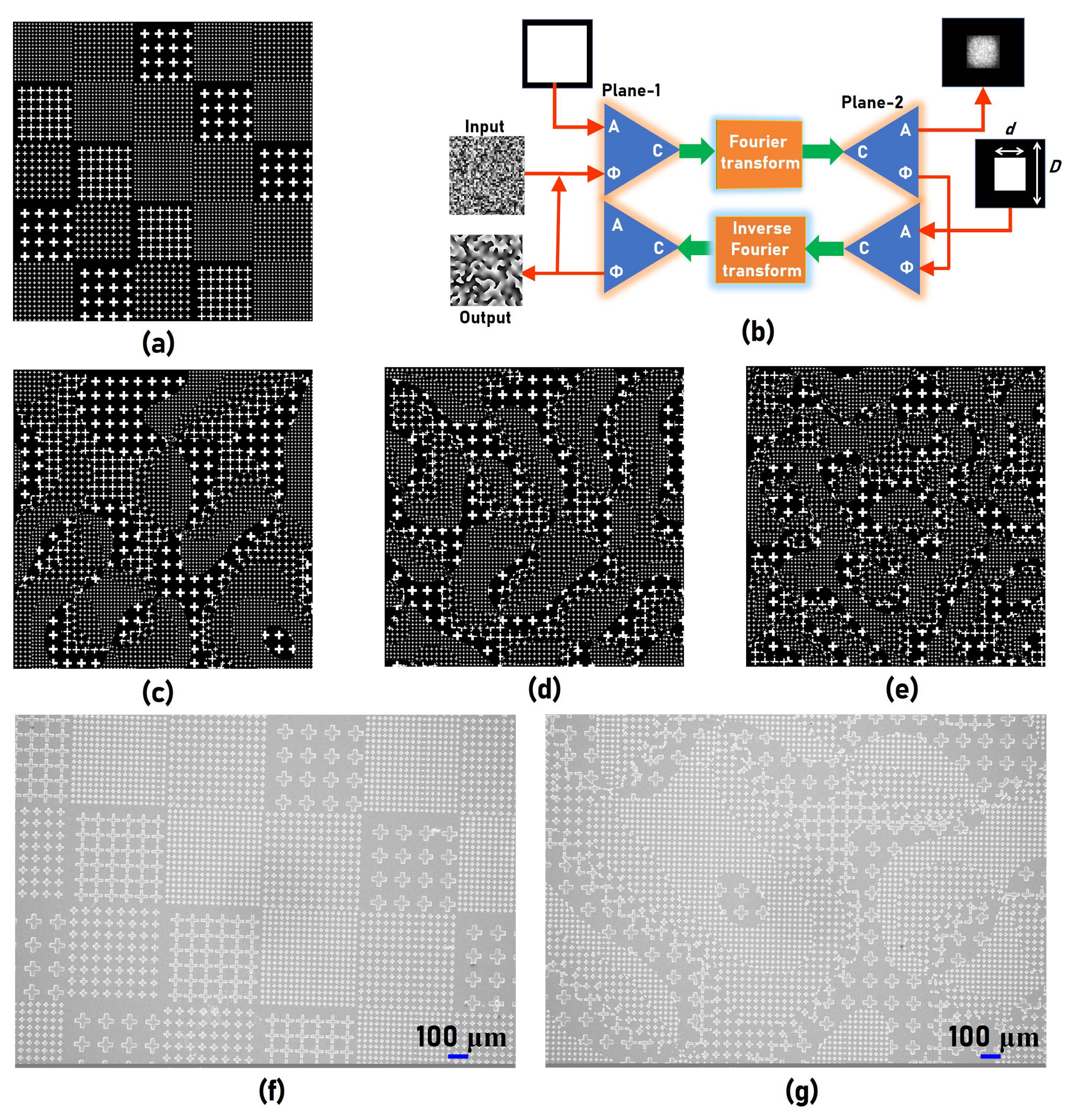The ATR condition can be altered by a refractive index change in the sample due to the phase transition of ice to water, or due to light tunnelling through small air gaps between the surface of the ATR prism and the sample. Even then, the ATR setup can be made useful by applying a top reflecting mirror. These conditions are discussed below together with spatial intensity-spectral filters, which can help to streamline THz band detection in the sample at specific wavelengths. Finally, the orientation of a sample can be exploited together with polarisation in the ATR setup, which is currently not used to its full potential. Recent results based on measurements using synchrotron-ATR at the Australian Synchrotron are presented, and the concept of polarisation-discriminated measurements is outlined.
2.1. Attenuated Total Reflection
The technique of attenuated total reflection (ATR) spectroscopy has become a popular method to measure the dielectric properties of materials [
11,
12]. It relies on total internal reflection within a prism and the resultant evanescent wave that extends beyond the ATR prism surface. A sample is placed on this surface, and the incident energy is absorbed only via the evanescent wave generated between the sample and ATR prism. As such, there is a reduction in the reflected signal intensity at the total reflection angle, when there is no transmitted light into the sample (placed on top of the ATR prism). The advantage of the method lies in the fact that solid and liquid samples can be studied with minimal preparation. This is exceptionally useful for the THz spectral window since free space propagation of THz radiation under normal conditions is strongly attenuated, due to absorption by water vapour. The observed ATR spectrum is noted to be nearly equivalent to that of the transmission mode. If the absorption of the evanescent wave is negligible, the penetration depth of the evanescent E-field (
-level) is given by the following [
13]:
where
is the wavelength,
and
are the real parts of the refractive index of the ATR crystal and sample, respectively, and
is the angle of incidence of the incoming radiation; for the beam intensity
, the penetration depth becomes
. Since
has to be a real number,
sets the limit on the refractive index of the sample for a given ATR crystal. ATR finds its use at infrared frequencies of 30 to 400 THz, where the
is of the order of 1
m for biological tissue. At these distances, the total absorption of the evanescent wave at distances in the order of the
is, indeed, negligible. However, at low terahertz frequencies (0.3 to 3 THz) the wavelength
is on the order of 1.0–0.1 mm, which yields a
on the order of 0.02 to 0.2 mm. The absorption of the evanescent wave becomes not negligible at such depths in biological tissues. A more elaborate equation for the reflected wave intensity, using the complex refractive index
, where
k is the imaginary part of the complex refractive index
, is required when polarisation becomes important.
It is instructive to estimate what are frustrated—the total internal reflection (TIR) transmission predictions. This affects the intensity reaching different depths of the sample as well as accounting for the detected THz power losses when an air gap is formed between the sample and the ATR prism. The fraction of light intensity polarized in the plane of incidence (p-pol) at the wavelength
, transmitted across the gap of width
d, with refractive index
, and in the case of the ATR prism of refractive index
n, is given as follows [
14] (
Figure 1):
where
is the angle of incidence onto the first surface (ATR prism); the same material of refractive index
n is considered on both sides of the gap. This set of formulas also shows that a larger light penetration depth can be achieved if a sample on the ATR prism has high refractive index inclusions. When the inclusion has a larger refractive index, compared to its surroundings, the frustrated TIR conditions applies, and light tunnels through the separation with a lower refractive index. This situation is illustrated numerically in
Figure 1b. Larger sub-wavelength depths in the sample can be optically excited by light tunnelling in the sub-millimetre wavelength region.
We demonstrate the ATR technique for determination of the THz penetration depth into bio-materials at different temperatures, using synchrotron radiation (the Australian Synchrotron) in the frustrated reflection mode with the Au-mirror placed above the 2 mm-thick sample [
15,
16].
2.2. A Useful Condition When Atr Becomes Invalid
When measuring the reflection of THz radiation in the ATR geometry at
, the ratio of the refractive indices of the diamond prism
and sample
is important since the ATR occurs at
(Equation (
4)). This sets
and is critically important in the characterisation of bio-materials close to this ATR condition (a heating/cooling compatible ATR unit is shown in
Figure 2a,b). With water
and ice
at
THz, direct transmission into the sample takes place (
Figure 2c). This change in the refractive index can be exploited for better depth characterisation of materials, due to the larger penetration depth of the evanescent field and direct transmission into the sample. The latter case requires modification of the measurement technique via the addition of a top reflecting mirror to redirect THz radiation back to the detection direction along the ATR geometry (
Figure 2c) as we introduced recently [
16].
The optical path length
in the case of the transmission mode in the ATR setup is defined by the distance,
H, to the mirror (see drawing in
Figure 2c) as
(from Snell’s law
and the Pythagorean identity of sin and cos functions, one finds
). Precise determination of
H is important since the surfaces of the ATR prism and sample housing unit usually have height differences of tens-of-micrometers;
Figure 2a,b. Power reflected at the first prism–sample interface is
, where
R is the energy reflection coefficient and
is the incident power. Considering a perfect reflection
at the top-mirror, the power re-directed back to the detector is
.
The experimentally measured ratio . The absorption (optical losses) coefficient is then . The reflectivity coefficient (power, intensity) is defined by the angle of incidence and the complex refractive indices of sample and ATR-prism , where is the permittivity.
For the normal incidence and lossless ATR diamond prism , the reflectivity from the sample () is and the absorbed part of energy is since there is no transmission . The Beer–Lambert law defines the transmitted part in a single pass through thickness ; , where the optical density (absorbance) is calculated from transmittance (note that this expression can be used for back-reflected signals in the ATR setup with a top mirror when the transmission is collected in the reflection direction and the ATR condition is not satisfied). For an arbitrary angle of incidence , the reflectivity for s-/p-pol. can be expressed as and , Fresnel’s sine and tangent laws, respectively.
The described measurement with the invalid ATR condition using a top-mirror allows deeper material interrogation, owing to the absorption from a much longer optical path as compared to that probed by the evanescent field (at ATR conditions) as shown in the plot in
Figure 2c. The penetration depth into the sample at ATR conditions is the sub-wavelength and the s-pol. probes half the depth as compared to p-pol. at the specific
incidence, regardless of the relative refractive index
. The penetration depth for s- and p-polarisations is as follows [
13]:
where
(sample/prism),
vacuum wavelength,
is the angle of incidence onto the prism–sample interface.
Example: Water in Butter around Water Freezing Conditions
The THz–ATR technique with a top-reflecting gold mirror is used to measure the absorbance of bio-materials [
15]. At the chosen ∼0.7–2.2 THz synchrotron radiation band, polarisation is mostly linear and corresponds to the s-pol. at the sample–prism interface. Freezing water reduces its real part of the refractive index only slightly (
n is proportional to mass density
); however, a very strong reduction in absorption occurs. Experimental values of ice reflectivity [
17,
18,
19] show a significant increase at the 56.5–75.0 cm
window (1.70–2.25 THz). Up to three times difference between the reflectivity of water (∼4%) and ice (
) to that of air is observed [
17,
18,
19].
Butter (Lurpak, a supermarket brand) has 14.7%
w/
w water, 3%
w/
w non-fatty solids, which are dissolved in the water, and the rest is fat [
20]. The temperature is varied from −20 to 24
C over a total time frame of 24 min with continual scanning; a total of 140 sets of 40 averaged scans are collected during that time span.
Figure 3 shows the reflectance evolution with temperature at two spectral regions. The inset presents reflectivity changes with temperature. There is a featureless temperature dependent reduction variation with butter, which is evident at the most sensitive frequency range of 0.95 to 1.0 THz. A considerably stronger temperature dependence of reflectivity is observed at the 2 THz band. Overall, the reflected ATR signal for Lurpak butter shows a 13% decrease over the −20
C to +24
C change at 1.0 THz and a 3.5% decrease at 2 THz. A slight decrease in reflectance with temperature variation ±20 °C around water freezing indicates that the water content ∼14.7% needs to be regarded as being “bound” in a homogenous mixture of fat and protein. The temperature-related reduction in reflectance in the region of 2.0 THz shows a plateau in the 2–12
C range. These results suggest that other materials with bound water may not show the effect of water freezing.
2.3. Polarisation and Field Enhancement at the Interface of ATR Prism
A unique feature of ATR geometry is that the maximum intensity of the incident beam, regardless of its polarisation, is localised at the interface (see details below and
Figure 4). This is defined by the conditions when light propagates from high-to-low refractive index (even at low angles of incidence when the ATR condition is not fulfilled). For normal beam propagation from low-to-high index (incidence from air), the intensity maximum is
above the surface due to interference between the incident and reflected beams. Maximum intensity at the interface using the back-side illumination is used in Raman scattering sensing and light-induced back-side wet etching (LIBWE) in subtractive machining [
21,
22].
The polarisation of the THz beam is not controlled, as the beam is delivered to the ATR prism. This is the condition when maximum intensity is obtained on the sample. The experimentally determined polarisation of synchrotron radiation at THz/far-IR beamline of the Australian Synchrotron (see
Appendix B) is 90% linear and 10% circular, due to the sum of the linear and circular polarisations at <100 cm
. This translates to the prevailing s-pol. on the sample placed on the ATR window for the measurements. For wavenumbers larger than 100 cm
, the ratio linear-to-isotropic polarisation is 20–80%.
For ATR measurements, the depth of the evanescent field is larger for the p-polarisation as compared with s-pol (
Figure 2c; Equation (
3)). It is important in the case of the frustrated total internal reflection (TIR) modelled for the non-polarised light by Equation (
2) (see
Figure 1b). In addition, E-field enhancement for the component of the E-field perpendicular to the interface between two dielectrics can be harnessed. Indeed, the boundary conditions of the Maxwell equations require that the normal component of the displacement
be continuous across the boundary (when there are no surface charges), and
is the permittivity at the corresponding wavelength—the
. Hence, the
in both the air and diamond are the same, which defines the E-field enhancement
since
. Note that here, we assume the E-field inside the ATR prism as a reference to calculate enhancement at the air–diamond interface (on the air side). For comparison, reflection at the normal incidence from the vacuum onto the diamond prism with
has
defining the transmitted
fraction of THz radiation (would be inside the ATR prism).
The penetration depth of the evanescent field depends on the wavelength of light in the ATR geometry (see the bottom row in
Figure 4). The intensity distribution in the case of frustrated TIR depends on the normalised gap
(Equation (
2);
Figure 1b). It shows that depending on the angle of incidence and refractive indices, light transmission can take place only when gaps are sub-wavelength. In standard ATR measurements, such frustrated TIR conditions can take place due to the presence of structures and different inclusions of a higher refractive index in the sample. The wavelength scaling in frustrated TIR gives insights into light tunnelling, regardless of the wavelength. Based on this Maxwell’s scaling, it is useful to model light transmission, reflection and enhancement at the interface of the ATR prism, using finite difference time domain (FDTD) calculations (lumerical solutions).
Figure 4 shows the results for the IR-visible spectra range; however, the predictions are universal as long as the refractive index is the same. To model a sub-wavelength inclusion inside a sample, a sub-wavelength diameter sphere of different refractive indices, dielectric (1.3 and 2.2), as well as metallic (Au) are chosen. Without the sphere, localisation of the evanescent field at the interface protruding into air gap for length comparable with
is clearly recognisable. An extra enhancement of the local E-field at the interface occurs in the nano-gap regions around the sphere. This is an illustration of the E-field enhancement of the normal
component discussed above. For the ATR measurements, the local field enhancement around inclusions of difference refractive indices would cause a stronger contribution from those regions where the light intensity was larger. Overall, the volume where the light field intensity is augmented around a sub-wavelength inclusion increases (see the same intensity
markers in the top-row maps in
Figure 1a).
2.4. Polarisation Analysis with Atr
Polarisation analysis in ATR measurements can be explored by using in-plane anisotropy of the sample and along the direction of the evanescent field. All 3D orientations can be sampled for changes in the refractive index and absorption. The real and imaginary parts of the refractive index play their part in defining the polarisation at the output of ATR and are discussed in this section.
The popular four-polarisation (4-Pol) method [
23] allows determination of the orientation of the absorbing molecular dipoles in the IR fingerprinting spectral range. It can be used to observe a complex molecular arrangement using microscopy and, when combined with high brightness synchrotron radiation, opens the possibility to observe the change in molecular ordering during phase transitions and crystallisation in real time. Monitoring phase transitions at the spectral window for vibrational–rotation energies at <33 cm
(<1 THz) can provide insights into nanoscale mechanics and material re-organisation, and are not usually accessible at low-brilliance (non-synchrotron) sources. For example, Debye rotation, network stretching, and rocking and wagging librations of water molecules all are active at the low-THz spectral band [
24]. Recently, the 4-Pol method was implemented to reveal molecular ordering in paracetamol (type-
) micro-crystals, which are better soluble in water [
25]. The principle of measuring absorbance at four sample orientations (or beam polarisation) using linearly polarised light is applicable to any spectral range. Patterns of sub-wavelength,
, features can be revealed by measuring angular dependence of absorbance/transmittance [
26]. The separation of transmittance changes due to birefringence,
, and dichroism,
, in polariscopy (with an aligned polariser and analyser) can be realised, due to the difference in angular dependence of those two contributions, using the 4-Pol technique [
27].
Our conjecture here is that the 4-Pol method of orientational probing of absorbance could be also adopted for ATR with one light E-field oriented in the plane of the prism surface (s-pol.) and another perpendicular to it (the evanescent field of incident p-pol.). Developing the 4-Pol method for ATR is our next motivation for experiments on the THz beamline at the Australian Synchrotron. The conjecture is based on basic principles of the polarisation analysis and is applicable to any wavelengths in the ATR measurements.
To select the required orientation of linear polarisation, a polarised mesh-grid is used. Polarisation is defined in the plane of incidence as
and
, which are ⊥ and ‖ to the plane (or TE and TM modes), respectively. By rotating the mesh-grip polariser by an angle,
, the linearly polarised power (energy, intensity),
I, in the plane of incidence, is defined by
components;
corresponds to the pure
light [
28]. Depending on the angle
, a different ratio of the
and
near-field (
Figure 5) are created in the sample. Those two components are absorbed differently, depending on the anisotropy of the sample, i.e., alignment of absorbers.
The phase and amplitude changes upon ATR reflection (
Appendix A) show that one would expect an elliptically polarised light emerging from the ATR prism (even without sample, see inset in
Figure A1b and
Figure 5). The beam after the prism can be analysed with a linear analyser, which is set to determine
and
polarisations. The most general expression of the THz power measured after the ATR prism would be the addition of two perpendicular contributions along the s- and p-polarisations:
where
are the arbitrary amplitudes accounting for both absorption (losses) and changes in amplitude due to reflection;
are the phases for s- and p-polarisations, respectively. The angle
defines the orientation of the linear polarisation in the incident beam, i.e., for
, only
polarisation is present, and
corresponds to pure
. When pure
polarisation is incident on the sample and there are no changes in the phase of the reflected beam, the orientational output power will have a horizontally aligned figure-8 (
Figure 5) and, consequently, for the pure
case, a vertical figure-8. When the incident beam has both
and
fields, which are absorbed along the z- (evanescent) and y-directions, the emerging field can be modelled with the Equation (
4), where changes of phases are also set as fitting parameters. The phase change upon reflection of s-/p-polarisations (TE/TM modes) are solely defined by the real part of the refractive index.
The THz beamline receives ∼20% of a linear
(along the slit of the first mirror) polarisation, contributing to
, and the remaining 80% is isotropic
(circular), contributing to the
and
at frequencies larger than ∼3 THz [
28] (see
Appendix B for experimental details of the synchrotron beamline). The transmitted power through a metallic linear-grid analyser at the entrance port
to ATR prism is
(shown in
Figure 6a). This is an expected angular distribution at the
port if there is no polariser. After the ATR, with no absorption for s- and p-components (
) and no phase change (
) upon reflection (see Equation (
4)), the same angular dependence is expected. However, even without any sample, the beam reflected from the ATR prism will change its polarisation, due to phase changes for s-/p-polarisations
, respectively (Equation (
4)); see
Figure A1b where the s-pol. (TE) experiences an advance of phase by ∼
, while the p-pol. (TM) reduces the lag of the
phase by a similar amount at the
angle of incidence on the ATR prism. As a result, just by reflection without any sample, there is a change in polarisation at the OUT port. With the sample, the refractive index contrast (real parts) changes those phase shifts. However, any anisotropy in absorbance
will change the amplitude of the reflected signal at the corresponding polarisation. This would also cause a change in the polarisation of the outgoing beam at OUT port. Equation (
4) accounts for all those changes.
Figure 6 illustrates the use of Equation (
4) for analysis of beam at the OUT-port of ATR. The analysis is based on two perpendicular field components,
and
, with independent amplitudes. Isotropic and anisotropic absorbance changes are accounted for by the coefficients
. Changes of phases of the s-/p-components with the sample (
) placed on top of the ATR prism (
) are accounted for by the
. Isotropic absorbance in y- and z-orientations is presented by the curve
2 with
and phase changes corresponding to reflection from the low refractive index material (
Figure A1b). Anisotropy along the y- or z-direction in the sample is modelled by a 20% change in coefficient
. As a result, the figure-8 (dipole-like absorbance) is rotated/tilted (an angular shift is introduced). This illustrates that polarisation analysis of the ATR results can be a useful tool for the measurement of anisotropy in the refractive index as well as absorbance by fitting Equation (
4) with the experimentally measured data with the polarisation analysis at the OUT port. The TM-mode can experience strong field enhancement at the interface (
Figure 4) and can cause additional absorption. Sub-wavelength structures at the sample-ATR prism interface cause depolarisation of the
E-field components, e.g.,
in the sample’s frame of reference (
Figure 5a); here, the intensity of the incident beam is
. The above described polarisation changes in the case of ATR should be possible to determine, using polarisation analysis at the OUT port and it will be carried out in future studies.
Equation (
4) can be fitted by
, which is used for the 4-Pol method (see the synchrotron radiation angular distribution in
Figure 6a, plotted with such dependence). The angle
indicates orientation of the sample (e.g., absorbing dipoles) and
and
with
, the maximum and minimum intensities of the transmitted or reflected light. By analysing the OUT-port polarisation and using the 4-Pol fit, it should be possible to establish anisotropy in absorbance (
) and refractive index ratio
defining
. For large samples fitting on 3-mm-window of ATR, sample rotation can be used to realise the 4-Pol method (
Figure 6b). Visualisation of the 4-Pol-ATR method (
Figure 6) is extendable to the hyper-spectral dimension since a broad THz spectrum is recorded. Metallic grid polarisers are polarisation insensitive and by measuring spectra at several angles with the analyser on the OUT port or by rotating the sample on the ATR prism, sample anisotropy can be examined. One can envisage an ATR geometry, where the entire ATR prism with a fixed sample can be rotated (around the z-axis (
Figure 5)). Such measurements would require a hemispherical or conical ATR prism and could provide a more flexible setup, e.g., as it is realised for the synchrotron IR microscopy with the Ge-prism [
30,
31]. The realisation of the polarisation rotation on the sample stage is established in visible light polariscopy, where it is based on an electrically controlled optical phase retardance in a liquid crystal cell [
32].
The high sensitivity ATR detection is realised with multi-reflection prisms, where the number of reflections at the sample–prism interface can occur over ten times before the light is detected [
33]. Amplitude and phase changes for such a situation become cumulative, and the reflection (for the E-field) can be expressed as follows [
34] (for ATR geometry):
where
is the refractive index of the ATR prism,
is the complex index of the sample,
is the field reflection coefficient calculated from the experimentally measured reflectance
R spectrum, and
is the phase change introduced by the ATR prism. The refractive index
of the sample is then the following [
34]:
and can be determined at each wavelength where the reflectivity
was measured, while the phase
is derived via Kramers–Kronig relation from
. It is usually possible to calculate the reflectivity and phase changes from a single reflection for the entire number
N of reflections (see Equation (
5)) as
, where
and
are the corresponding changes occurring at the single reflection [
35].
2.5. Feasibility Test
The s- and p-pol. polarisation ratio of the synchrotron THz beam is not the same on the sample, due to multiple reflections caused by mirrors in the ATR unit (
Figure 7a). The THz beam reflected from the sample–prism interface experiences further reflections until it reaches the OUT port. In total, from the IN to the OUT port, there are ten reflections, including one from the the sample. The beam inside the ATR unit is focused by parabolic mirrors and experiences a change in the s-/p-portions, due to the change in the direction of propagation inside the unit. Due to focusing onto the sample (a 3 mm window), a range of incidence angles are covered, which contributes to different Fresnel reflection coefficients and a change in the phase.
The polarisation response of the ATR unit without sample (in air ambient) is analysed. A mesh grid polariser is set at the IN port and an analyser is set at the OUT-port. Linear (horizontal) polarisation is set to enter the ATR unit, which corresponds to the linear pol. of the synchrotron radiation (
in
Figure 7b). A spectral window of 30–630 cm
is selected with the beamsplitter, and the detector is a Si bolometer. A mesh-grid polariser/analyser has the same extinction ratio
over the all wavelengths used;
is the transmission at the maximum and minimum orientation of the polariser, respectively.
The measured ATR reference signal without a sample is only affected by the THz active absorbers/scatterers in air; hence, mostly water at the spectral window is used. The calculated water spectrum over this spectral window in shown in the inset of
Figure 7b. The evanescent field extends ∼
into the air and experiences absorption and phase changes of s-/p-pol., corresponding to the refractive index ratio
(without the sample with
). The result of the change in polarisation between the s- and p-pol. and beam focusing (range of incidence angles) is a low extinction ratio for the entire unit
. There is strong light leakage from the ATR unit, even in the crossed polariser–analyser conditions shown in
Figure 7b; the
of the mesh grid polarisers is ∼10
. The influence of the input polarisation and internal inter-change between the s- and p-pol. is revealed by co-rotating the mesh grid polarisers at the IN and OUT ports (
Figure 7c). More angularly narrow s- and p-pol. lobes are observed, as compared to the extinction ratio measurements shown in
Figure 7b and the cross vs circle markers in
Figure 7c. There are two maxima and two minima per
-range of the
rotation, marked as Angles 1–4 in
Figure 7c. The intensities of the components are fitted with
and
with phase angles set
. The value of the phase angle is larger than the possible alignment error of the polarisers, which is smaller than
. Cumulative phase changes on the nine mirrors and the ATR prism (ten reflections) are the most probable cause of this phase change. Due to co-rotation of the polariser and analyser (on the IN and OUT ports, respectively) the change between s- and p-pol. becomes easily detected since such an alignment has the maximum transmission for the same polarisation, either s- or p-pol. Indeed, the fits plotted by the expressions given above miss the experimental results by a large margin (not shown in an already busy panel (c)). The solid lines in
Figure 7c show a good fit when the
and
are used with
, which corresponds to the number of reflections without two reflections from the flat M1 and M10 mirrors. Each reflection on the mirror contributes to the overall transmission
.
A perfect fit of the output signal (port OUT) can be obtained by the combined
and
intensity addition by Equation (
4). The
are the arbitrary amplitudes accounting for both the absorption (losses) and changes in amplitude due to reflection;
are the phases for s- and p-polarisations, respectively. The angle
defines the orientation of the linear polarisation in the incident beam, i.e., for
only
polarisation is present and
corresponds to pure
. When pure
polarisation is incident on the sample and there are no changes in the phase of the reflected beam, the orientational output power will have a horizontally aligned figure-8; consequently, for the pure
case, it will have a vertical figure-8.
Figure 7d shows the polarisation analysis at the OUT port when the IN port polariser is set to one of the local min or max orientation angles (Angles 1–4 shown in
Figure 7c). Changes in the amplitude and phase angles at four settings of Angles 1–4 are colour coded in the legend in
Figure 7d. This shows that Equation (
4) can be used for the arbitrary orientation of polarisation at the IN port.
Changes in amplitudes due to absorption in the sample and phase angle changes are due to refractive index contrast and can be accounted for using a fixed polarisation for excitation then carrying out polarisation analysis at the output. It is also obvious that such analysis has to be carried out for each spectral point.
2.6. Combined Spectral Filters and Polarisers
A toolbox of spectral filters and polarisers are required to fully explore the potential of spectroscopy for material characterisation. Such a toolbox is less developed for the THz spectral range. However, due to the low-resolution photolithography required for longer sub-millimetre wavelengths, spectral filters can be easily made based on a square lattice (
Figure 8a). Here, we introduce the concept of filter multiplexing for control over the transmission wavelength, bandpass, and amplitude. Such comb filters can be made by direct laser cutting [
37] from a metal foil or by standard photolithography. For the chosen wavelength
[
m], the period
, the length of cross opening
, and the width of the opening
[
38,
39]. The typical 10–15% bandwidth
for the geometry defined above becomes smaller as the
and
ratios are increased, while the centre frequency of the band-pass filter is mainly dependent on the cross-member length
L. It is demonstrated that transmission
can be obtained using micrometer-thick Cu-foil within the 0.5–2 THz spectral range, using the presented scaling [
38].
With the known spectral profile of the synchrotron source (inset of
Figure 8b), it is possible to design a transmission mask, which filters spectral bands and sets their intensities. Such filters are numerically designed to produce a comb of THz frequencies (five for the pattern shown in
Figure 8b). As is known, it is desirable to have a uniform spectral response such that the gain of the bolometer can be precisely set in advance. The spectral profile can be precisely engineered by spatially multiplexing cross-filter designs corresponding to different wavenumbers. The first method is a super-pixel type spatial multiplexing, where every pixel of the mask is formed by the mosaic of the building block of the different filters. A super-pixel design with
elements is shown in
Figure 9a. This is the most straightforward approach, but results in undesirable diffraction orders due to the periodic configuration. The second approach uses a random phase mask. In principle, any random phase mask will work, but in order to allow at least certain number of crosses of the same type, it is crucial to engineer the scattering ratio of the random phase mask. Such quasi-random phase masks can be synthesized using the well-known Gerchberg–Saxton algorithm (GSA) by giving the scattering ratio as the input [
41]. The schematic of the GSA is shown in
Figure 9b. The algorithm begins with a complex amplitude consisting of a uniform amplitude and random phase function at Plane 1, which is Fourier transformed. The amplitude in Plane 2 is replaced by a uniform amplitude within a predefined area, which decides the scattering degree given as
, where
d is the length of the predefined area and
D is the length of the total area. The output of the GSA is a quasi-random phase mask, consisting of grey levels from 0 to 2
. As the area of every different phase level is equal, different grey level ranges can be set to different filters. By controlling the relative ranges, the relative intensity responses can be manipulated. The images of a section of spatially randomly multiplexed cross-filters for
,
and
are shown in
Figure 9c–e, respectively. The use of photolithography on thick 20–500
m SU8 laminates (SUEX from DJ Microlaminates Ltd.) is particularly appealing, due to the possibility of retrieving free-standing mesh filters. With a gold (or any other metal) coating, this completes the filter. The SEM images of the mosaic type comb type and randomly multiplexed cross-filters on gold-coated SU8 films on silicon substrate are shown in
Figure 9f,g, respectively.
Due to the isotropic geometry of the cross lattice and symmetry of the square lattice, an isotorpic polarisation response is expected [
42]. Polarisation active filters can be fabricated using the same approach. Due to silicon’s high transparency in the THz spectral band and readily available Si plasma etching for high aspect ratio structures, optical elements, such as optical vortex generators for spin and orbital angular momentum (SAM and OAM), manipulation at THz frequencies can be made [
43]. A Fresnel rhomb with an apex angle ∼55
made from THz-transparent teflon or cyclic olefin copolymer TOPAS [
44], which have a refractive index of ∼1.5 over a wide THz spectral range can be used for a quarter waveplate generator of circular polarisation out of the linearly polarised input. This is especially useful for bio-medical and pharmaceutical applications where left- vs. right-hand enantiomers and chirally active molecules have to be detected.
Long wavelength (low frequency) optical radiation is promising for opto-mechanical applications [
45,
46,
47,
48,
49,
50,
51]. Indeed, the reaction torque exerted onto an object by a beam of power
P is
, where
is the before–after change of the circular polarisation state [
52].
